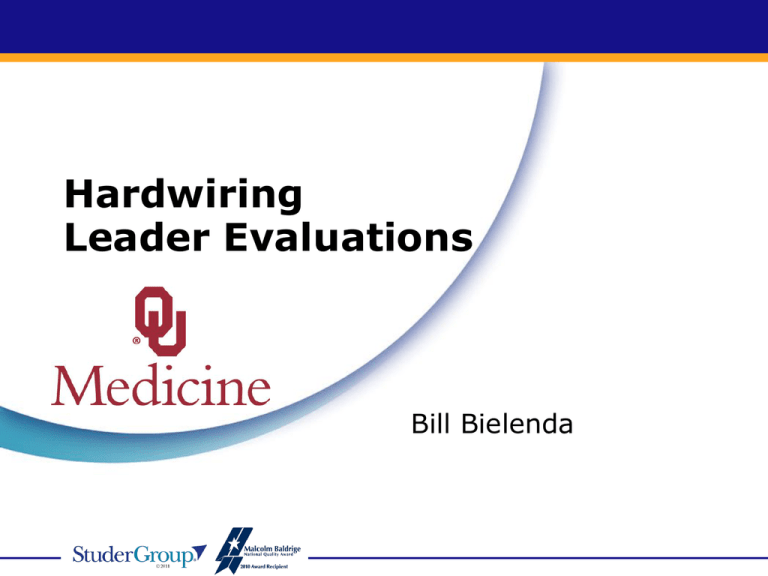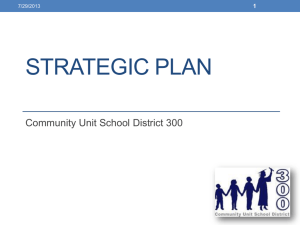Goals - OU Medicine
advertisement

Hardwiring Leader Evaluations Bill Bielenda What you will learn today… Importance of leader accountability and goal alignment How to develop effective goals The basics on accountability tools Healthcare Flywheel® Bottom Line Results (Transparency and Accountability) Prescriptive To Do’s Purpose, worthwhile work and making a difference SelfMotivation ® Evidence-Based LeadershipSM (EBL) Objective Evaluation System Leader Development Aligned Goals Implement objective accountability system Better align training to outcomes Must HavesSM Performance Gap Aligned Behavior Sequence tools and techniques Retain High Performers, Coach Mid Performers, Help deal with low performers Standardization Accelerators Aligned Process Hardwire consistency Healthcare is trying to build world class performance on prehistoric evaluation systems. Quint Studer Leader Evaluation: Comparison of those organizations that have the leader evaluation process hardwired and those that do not Source: Studer Group® October 2008 Measurement Spreadsheet; Organizations that hardwire the leader evaluation process in their organization, show patient perception of care ratings that are significantly higher than those that do not. Patient perception of care mean score average includes all partner selected vendors including Arbor, Avatar, Gallup, HCAHPS, Healthstream, Jackson, NRC, PRC Picker, Press Ganey, RPM, and Statisquest. Year 1 – Goals Reduce Costs / Issue Improve Financial Performance Achieve financial margins of: – 4.0% in FY ’06 – YTD 4.6% more detail> –5.0% in FY ‘07 Provider of Choice (patient satisfaction) Achieve organization-wide average patient satisfaction scores of: – 93.7 for “Overall quality of care/services” – YTD 93.5 – 76.1 for “Would Goals you recommend” – YTD 73.5 Employer of Choice (employee satisfaction) Reduce overall turnover of: – “permanent” positions to11% – YTD 14% more detail> – “permanent” core RN positions to 13% – YTD 16% Improve Care (Quality, Safety, Effectiveness) Achieve 90% compliance with CMS measures: Community Acquired Pneumonia 3>90% - 5<90% Surgical Infection Prevention 1 >90% - 2<90% Heart Failure 2>90% - 2<90% Acute Myocardial Infarction 5>90% - 2<90% Achieve 90% compliance with evidence-based practice for prophylaxis of the following: DVT/PE, Post-op UTI, Post-op Pneumonia, Post-op AMI, Pressure Sores, Post-op Sepsis Information Management – Implement Employee Satisfaction Assessment process during 2005 – Create projected timeline for the implementation of the Advanced Point of Care (APOC) clinical system Leader Evaluation Results – Year 1 Year 2 – Goals Excellence Service Increase Patient Satisfaction (Inpatient) Goal = 62nd Current = 51st People Reduce Annualized Turnover Goal = 14.5% Quality Decrease Mortality Index Goal = .77 Current = .77 Finance Operating Margin Goal = 5% Increase Inpatient Admissions Current = 5.6% Goal = 2.7% Current = 7.6% Current = 16.7% Increase Patient Satisfaction (Ambulatory) Increase Employee Satisfaction Growth Reduce FTE per Adjusted Discharge Increase Outpatient Visits Goal = 1.15 Goal = 62nd Current = 65th Current = 1.15 Goal = 5% Current = 8.0% Leader Evaluation Results – Year 2 Note: Percentages noted account for 93% of the leaders who have entered data as of 6.7.07. Financial Impact: Hospital Acquired Infections Percent of HAI Over Admissions Metric Reduction Hospital Acquired Infections 156 Incremental Costs $1.93 million Bed Days Avoided Tactic and Tool Implemented: Objective Evaluation System Source: Arizona Hospital, Total beds = 355, Employees = 4,000, Admissions = 10, 188 HFMA article, “When Hospital Infections Go Down, Pay Raises and Bonuses Go Up at UMC”, July 2009 984 Why Have Leader Evaluations Based on Objective Goals? Clearly connects the goals of the organization to individual leader Provides prioritization roadmap for leader Reduces unnecessary work and duplication of efforts because clear expectations are set Keeps leaders focused on what is really important Allows senior leader to continuously monitor leader performance Provides for organizational agility Competencies do not guarantee desired outcomes Goal Alignment & Balance What is goal alignment? Insuring that individual leader activities are consistent with the goals of the organization. Vertical Alignment ORGANIZATION GOALS DIVISION GOALS DEPARTMENT GOALS LEADER / UNIT GOALS Horizontal Alignment ORGANIZATION GOALS DIVISION GOALS DEPT X GOALS DEPARTMENT GOALS DEPT Y GOALS How Organizational Balance is Defined Research Education Growth Finance Quality Service People MISSION Integrating and connecting the vision, value and goals of the organization into daily decisions, behaviors and actions Goal Development Process 1. Senior leaders set organizational goals 2. Organizational goals are shared with all leaders 3. Each leader determines their goals and preliminary weights 4. Goals are reviewed by each leader’s reporting senior 5. Goals are shared within leadership team to insure everyone's needs are addressed 6. Goals are audited for continuity 7. Leaders finalize their goals Goal Development Goal Development Tips Develop quantitative goals. Goal Scales 5 = Stretch 4 = Partial Stretch 3 = Goal 2 = Partial Accomplishment 1 = No Accomplishment Example Goal with Rating Scale Growth Rating Scale Increase the number of procedures to 200. 5 is ≥ 250 4 is 225 to 249 3 is 200 to 224 2 is 175 to 199 1 is ≤ 174 LEM Score Distribution 3 3 1 2 3 4 2 3 4 Opportunity Target 5 Excellent Example LEM Results 147 Average Score = 3.07 72 39 17 0 1 1 2 2 3 3 4 4 5 5 Goal Development Tips Develop quantitative goals. Use language that everyone understands. Connect goals to purpose. Fewer, rather than more goals, are better. Goal Development Tips – Cont. It is not always practical to have a goal under each pillar. Goals should be aggressive yet realistic. Focus on results, not tactics or projects. Goal or Tactic? Conduct employee evals on time Improve staff productivity Round on 100% of inpatients Attend all leadership development sessions Pass OSHA inspection Define how much time goal must be sustained For fiscal year-to-date (FYTD) For the month of December For the 4th quarter For last 6 months of the year SMART Goals are Specific Measurable Attainable Realistic Time-bound What might not fit as goals: Standards of performance Subjective and vague statements Tactics to achieve goals Maintaining regulatory compliance Routine job activities Middle Manager Common Goals Examples: •Budget •Patient satisfaction •Employee satisfaction •Patient Falls Example Goals Laboratory - Example Pillar Weight Laboratory Goal Service 25% Achieve a percentile rank of 99 for test and treatments for the fiscal year. People 20% Reduce turnover to 15% annualized for entire fourth quarter. Finance 20% Meet expense budget of $2.10 per test for fiscal year. Quality 10% Reduce repeat test below 2% for last 6 months of fiscal year. Growth 25% Increase lab outreach tests by 5% for fiscal year. Patient Care Unit - Example Pillar Weight Med/Surg Unit Goal Service 30% Achieve a percentile rank of 99 for nursing care for the fiscal year. People 30% Reduce turnover to 25% annualized for fiscal year. Finance 25% Meet productivity target of 6.5 hours per patient day for fiscal year. Quality 15% Decubiti rate of 0% achieved by last 6 months of fiscal year. Growth 0% N/A Medical Records - Example Pillar Weight Medical Records Goal Service 20% Achieve an average 4.8 on support services evaluation for fiscal year. People 20% Maintain turnover level at or below 5% annualized for fiscal year. Finance 30% Achieve A/R days of 65 by year-end. Quality 20% Reduce inpatient denials by 20% for fourth quarter. Growth 10% In-house transcription revenue to increase 10% for fiscal year. Tools of Accountability Leader Performance Evaluation Leader Report Card 90 Day Work Plan No Surprises MONTHLY QUARTERLY YEAR END Thank You! For valuable tips on creating a culture of organizational excellence, visit our web site at www.studergroup.com Bill Bielenda 850-934-1099




